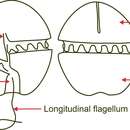en
names in breadcrumbs


Gyrodinium is a genus of dinoflagellates belonging to the order Gymnodiniales within class Dinophyceae.[1]
The genus has cosmopolitan distribution.[1] World Register of Marine Species lists 141 species, with many synonyms.[2]
They are heterotrophic (cannot produce its own food) and feed on diatoms (such as Chaetoceros debilis) that can be up to 12 times their length.[3] They are 'naked' dinoflagellates, meaning they lack armor (or cellulosic plates).[4]
54 species, as accepted by the GBIF:[1]
Gyrodinium is a genus of dinoflagellates belonging to the order Gymnodiniales within class Dinophyceae.
The genus has cosmopolitan distribution. World Register of Marine Species lists 141 species, with many synonyms.
They are heterotrophic (cannot produce its own food) and feed on diatoms (such as Chaetoceros debilis) that can be up to 12 times their length. They are 'naked' dinoflagellates, meaning they lack armor (or cellulosic plates).